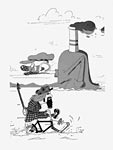






 |
|||||
 |
 |
 |
 |
 |
 |
|
|
The Natives Write BackBy the 70s the travelogues contain moments of irony that point to the fracture in this nostalgic, utopian, and fundamentally ideological attempt to fashion a Scottish heimat. They become ironic about their own discursive strategies: Aberdeen: By Seaside and Deeside observing the Highland Games remarks that 'of course, when one is so far north, there is the opportunity of viewing the weird pagan rites of the natives'. Highland Capital also uses the Highland Games to challenge the very notion of a place rooted identity: 'From up country and down country the clans have foregathered. From the highlands and islands, by sea and by air. Exciled Scotsmen from over the border, emigrant Scots from over the sea, there come MacKays from Toronto, the McNeils from Barra, MacDonalds from Texas and McLeods from Skye'. |
 Clydescope (1974) acknowledges the myth making of the travelogue. |
Similarly, Clydescope (1974) uses the on screen presence of Glaswegian born comic Billy Connolly to draw the viewer's attention to the gap between myth and reality that structures many travelogues: "Ours is a tale of the Clyde today, a holiday land which may not boast those medieval troubadours of ancient memory and the tourist copywriter, but still affords a warm welcome to the visitor from near and far." Island of the Big Cloth (1971) also differs in from the other travelogues discussed in the previous sections in that it employs, in its voice-over narration, what has been called the 'indigenous ethnographer', in this case one of the crofters. With the entrance of this figure, Clifford (1986) argues, 'Anthropology no longer speaks with automatic authority for others defined as unable to speak for themselves. Other groups can less easily be distanced in special, almost always past or passing times, - represented as if they were not involved in the present world systems that implicate ethnographers along with the peoples they study' (p. 10). In the Films of Scotland documentaries, it is the Scottish poets who explicitly make this point, as this extract from Sorley Maclean's Island (1974) illustrates: (Shots of three old men on a hill top digging peat) Sorley Maclean: Ever since I was a boy in Rasay, and became aware
of the difference between the history I read in books and the oral accounts
I heard around me, I have been very sceptical of what might be called
received history. The million people, for instance, who died in Ireland
in the nineteenth century, the million more who had to emigrate, the thousands
of families forced from their homes in the Highlands and Islands. Why
was all that? |
|
Maclean's narration rewrites the history of the islands, explicitly drawing attention to the difference between the dominant history found in school books and the oral accounts of the islanders. Further, it places this local history in the context of international, rather than exclusively national forces. Maclean narrates as one of the islanders, and his narration is structured to implicate the reader as sharing his 'native' position. In the majority of the travelogues, historical narration and ethnographic description are kept apart; while a documentary may switch between the two discourses, the two do not occur simultaneously. But this film is the exception, in the radical difference between the sound and image tracks: while the image track is exclusively ethnographic, the sound track engages historiography, writing a counter history to the official version constructed by the previous, and later, documentaries. In juxtaposing the two discourses, the text places the cultural group within the time-flow of history, reversing ethnography's tendency to construct rural societies as timeless. The juxtaposition also challenges ethnography's mode of address; the visual track invites us to observe another culture, while the sound track addresses us as listeners with a vested interest in that culture. (A group of people clip sheep with old sheers amongst the ruins of a
building) The history that Maclean narrates illustrates Greenblatt's (1992) argument that 'the possession of weapons and the will to use them on defenceless people are cultural matters that are intimately bound up with discourse: with the stories that a culture tells itself, its conceptions of personal boundary and liability, its whole collective system of rules' (p. 64). The actions of human subjects are inseparable from the way in which they represent themselves and others. |
|
|
In this sequence, as in other sequences in the film, personal and popular memory are articulated with the representation of a distinct way of life. The effect of this combination of historical and ethnographic discourse is not to reproduce Rasay as a sacred or enchanted space, but to represent it as a thoroughly politicised space in which the lives of the cultural group are deeply embedded in the socio-economics of modernity. The travelogue's narrative of a journey or tour orders and makes coherent other narratives whose function is to transform 'ordinary' places and people into something 'extraordinary', into sites/sights worth visiting, invested with symbolic capital and meaning. Sorley Maclean's Island indicates the way in which although these sites are embedded in powerful narratives, their meaning is not fixed and may be challenged. |
|

 |
|
| Author: Richard Butt | Images are drawn from the SCRAN database. |